Alexander the Great to John Phillip Holland
A history of submarines
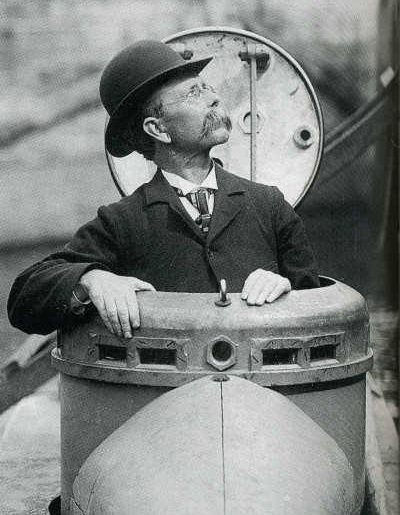
Wikimedia Commons
Alexander the Great - Siege of Tyre 332 BCE
The first recorded example of undersea warfare is the use by Alexander the Great of what we would now call a diving bell to inspect the underwater defences of Tyre in the third century BCE
Archimedes 287 – 211 BCE
A submarine follows the physical law of buoyancy, known as Archimedes’ Principle – which states “… that any body completely or partially submerged in a fluid (gas or liquid) at rest is acted upon by an upward, or buoyant, force, the magnitude of which is equal to the weight of the fluid displaced by the body.” Archimedes was a Greek mathematician and inventor.
A submarine on the surface is positively buoyant
A submarine on the surface weighs less than the weight of water it is displacing because its ballast tanks are empty (full of air). This increases the weight of water the submarine is displacing so that it is greater than the weight of the submarine.
A dived submarine is neutrally buoyant
A submarine dives by filling its ballast tanks with water. Prior to diving it will have adjusted its weight by distributing water in its (weight) compensating tanks so that the weight of the submarine with its ballast tanks flooded equal the weight of sea water the submarine has displaced.
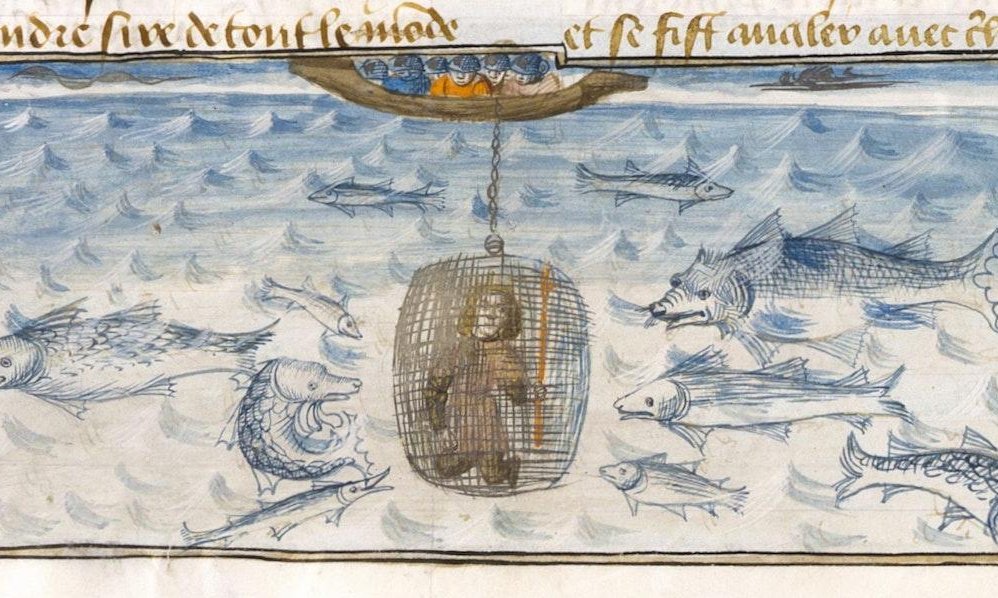
https://publicdomainreview.org/collection/alexander-bathysphere/
Miniature from a French manuscript of Roman alexander, ca. 1486, f. 56v.
Leonardo da Vinci - c1490
Leonardo da Vinci is said to have designed a submarine. “..He also mentions his invention for staying underwater for long periods. However, he does not reveal it “because of the evil nature of men,” as they would use it to sink enemy ships, causing the death of their occupants.”
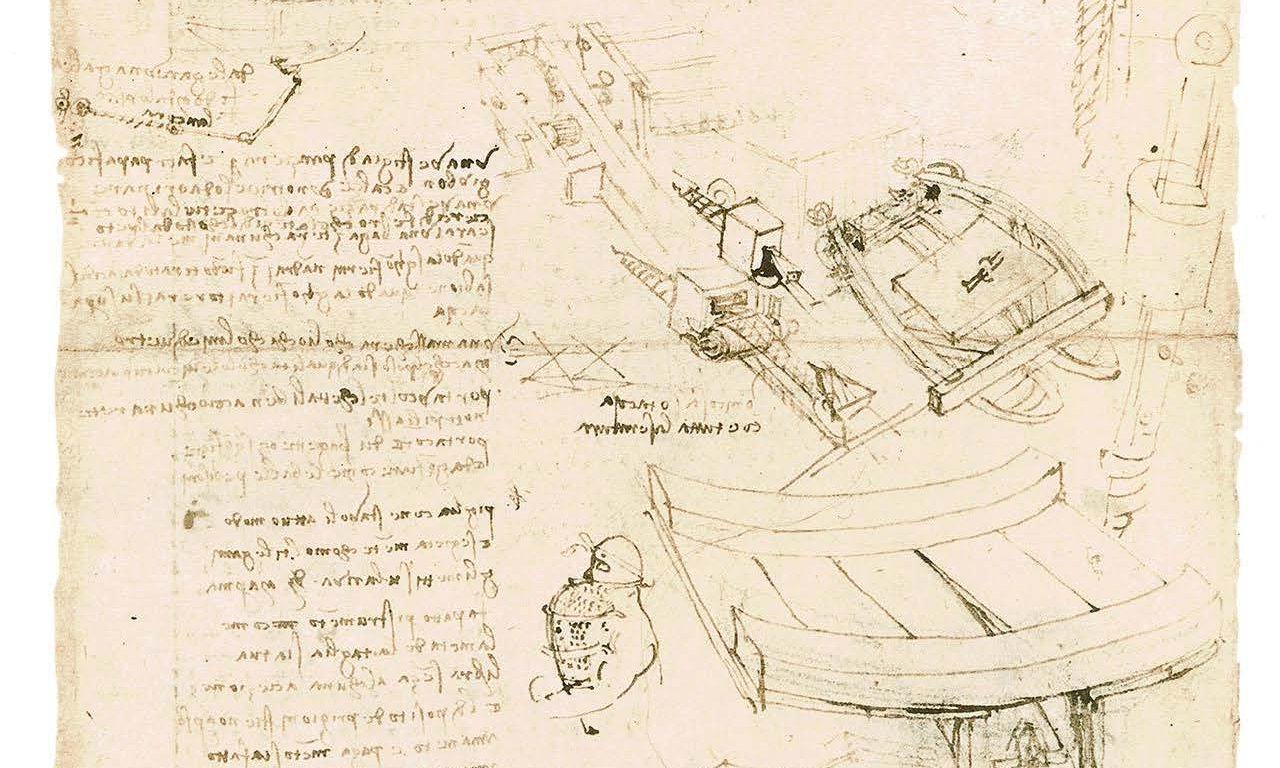
https://mostre.museogalileo.it/codiceleicester/en/water/50-leonardo-s-submarine
da Vinci’s design for a submarine
Cornelis Drebbel and King James I - 1620
“Cornelis Drebbel (born 1572, Alkmaar, Netherlands—died November 7, 1633, London, England) was a Dutch inventor who built the first navigable submarine.”
Drebbel’s patron was King James I, and on one occasion, the King sailed with Drebbel in his submarine in the Thames, thus becominig the first reigning monarch to travel underwater in a submarine.
“King James I invited Drebbel to England, and that’s where he did his work with submarines. None of Drebbel’s records survive. But accounts by others say he made his subs out of rowboats covered with watertight leather. Oars stuck out through watertight seals. Bladders were filled with water to allow a sub to descend; to surface, the water was squeezed out. Snorkel-like tubes brought in fresh air.
Drebbel built three submarines in all. They were tested by the Royal Navy in the Thames River in London. In one test, the sub stayed under for three hours, at a depth of about 15 feet. Thousands of spectators watched the tests, including King James. The king even went along for a ride -- one of the first passengers on a submarine.”
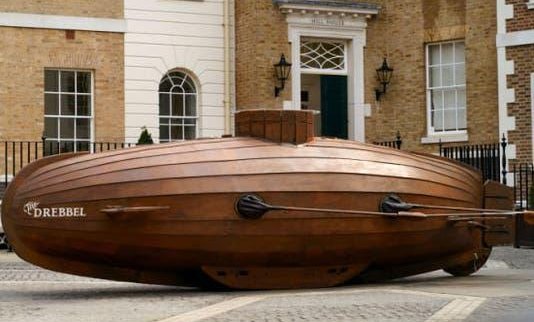
https://www.lindahall.org/about/news/scientist-of-the-day/cornelis-drebbel/
A smaller replica of Drebbel’s submarine – on display near Richmond Bridge, London
“In 2002, for a BBC special called "Building the Impossible," a reduced-size replica of a 4-oar Drebbel submarine was built and successfully navigated on a lake near Windsor Castle. This same replica was displayed at a special exhibition at the Royal Navy Submarine Museum in Gosport in 2010. Its normal resting spot is in a courtyard near Richmond Bridge in west London, where the photograph above was taken.”
Turtle in the American War of Independence - 1776
The first military submarine was Turtle in 1776. During the American Revolutionary War, Turtle (operated by Sergeant Ezra Lee, of the Continental Army) attacked but failed to sink the British warship, HMS Eagle (flagship of the blockaders) in New York harbour on September 7, 1776. There is no record of any attack in the ships' logs
“Fellow Yale students David Bushnell and Phineas Pratt invented an underwater bomb with a time delayed flintlock detonator. Bushnell invented the Turtle as a means of delivering the device. The one-man vessel submerged by letting water into the hull and surfaced by pumping out the water with a hand pump. Ezra Bushnell, the inventor’s brother, piloted the vessel during testing in the Connecticut River. On 6 September 1776, Gunnery Sergeant Ezra Lee used the Turtle to attack the British ship HMS Eagle. Unfortunately, Lee was unable to get the underwater bomb attached to the vessel. He lost contact with the Eagle, lost possession of the torpedo and was forced to resurface. While the system worked in theory, its first practical application failed.”
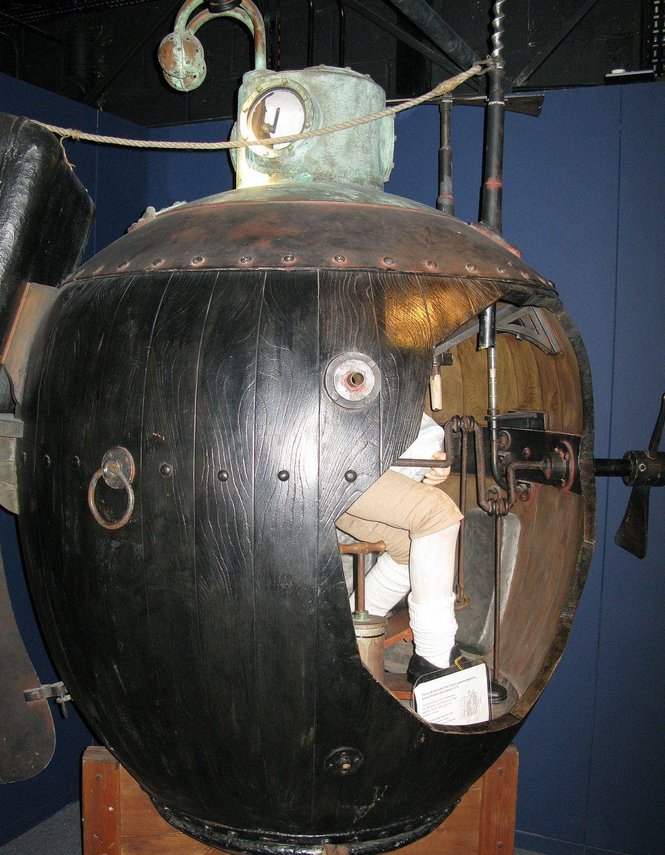
https://en.wikipedia.org
Turtle
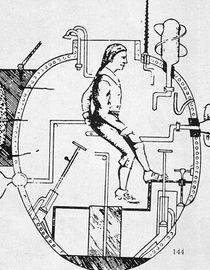
MPI/Getty Images
David Bushnell's experimental submarine, The Turtle - MPI/Getty Images
CSS Hunley Sinking of USS Housatonic
The First Successful Submarine Attack - 1864
The first successful submarine attack was conducted by the Confederate States Submarine H.L.Hunley on 17 February 1864 off the entrance to Charleston Harbor in South Carolina. The attack by CSS H.L.Hunley was part of the attempts by the Confederate Statesto break the blockade imposed by the United States during the American Civil War.
“The Sinking
On 17 February 1864, after months of practice runs and weather delays, the Confederate submarine, under cover of darkness, silently approached USS Housatonic, a 16-gun, 1,240-ton sloop-of-war, on blockade duty four miles off the entrance to Charleston Harbor, South Carolina. Carrying a torpedo packed with explosive black powder bolted to a 16-foot spar, H. L. Hunley rammed Housatonic below the water line, detonating the torpedo, tearing a hole in the Union ship’s hull and sending her to the bottom along with five of her crew. Hunley was not seen again for over a century.”
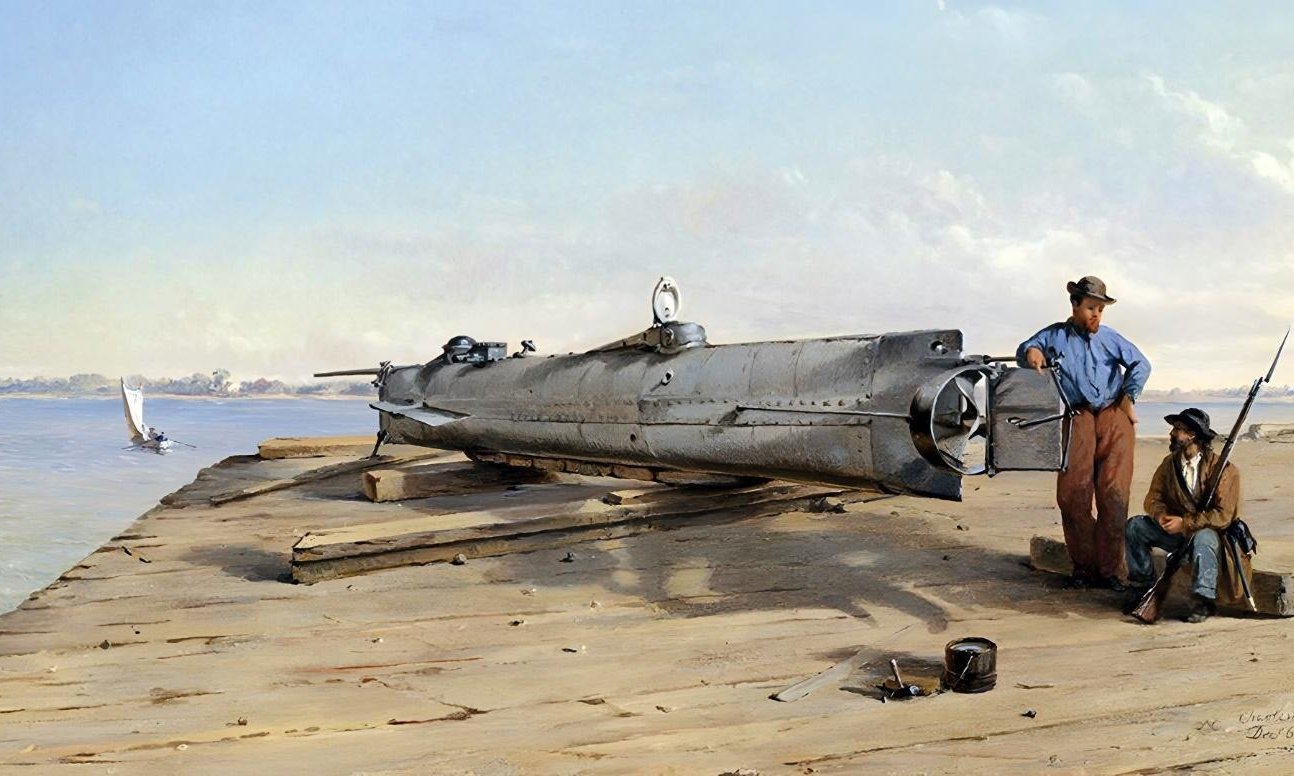
https://warfarehistorynetwork.com/article/weapons-confederate-submarine-h-l-hunley/
CSS H.L.Hunley
“The Boat Privately built in 1863 by Park and Lyons of Mobile, Alabama, with the financial backing of Horace Lawson Hunley, the submarine was constructed from rolled iron boiler plate with custom cast iron fittings. It was powered by a hand crank operated by a crew of seven, with an eighth member to pilot the boat. Each end was equipped with water ballast tanks that could be flooded by valves or pumped dry by hand pumps. With many of the features that would become standard in later submarines, including diving planes and raised conning towers, the boat is a prime example of the American technological ingenuity that characterized the Civil War period”
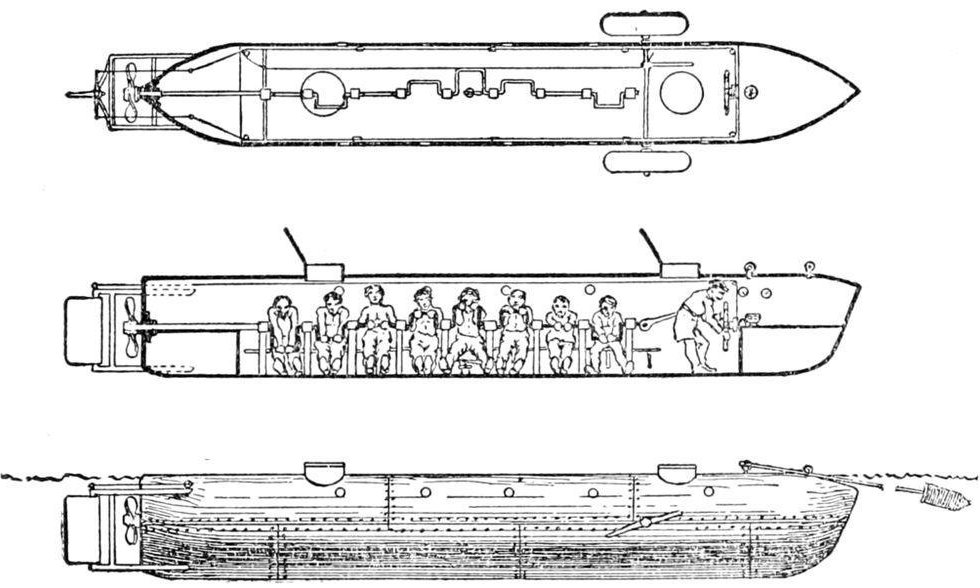
https://www.amusingplanet.com/2021/03/hunley-submarine-that-wouldnt-come-up.html
Drawing of Hunley from Popular Science Magazine, circa 1900.
The wreck of Hunley was discovered in 1995 and recovered in 2000. It has been undergoing conservation treatment in North Charleston, S.C., at the Warren Lasch Conservation Center. The wreck is on display at the centre
Narcis Monturiol – Ictineo 1864
Monturiol’s interest in submaraines was stimulated by his desire to examine and collect coral. His first attempt Ictineo 1 was powered Monturiol’s own pedal power.
Among other things, this experience taught him that he needed an alternative form of power to propel his submarine.
“In 1867, the Ictineo II launched successfully. Monturiol descended to 98 feet and yet, to him, the endeavor still seemed clumsy. It was hard to power a submarine with nothing but one’s legs.
Monturiol opted to develop a steam engine to be used inside the submarine. The steam engine, like the submarine, was not a new invention. It had been around for almost two centuries: Thomas Newcomen first patented the idea in 1705, and James Watt made innumerable improvements in 1769.
In a standard steam engine, hot air is forced into a chamber with a piston, whose movement produces the power to motor practically anything, such as a submarine. For Monturiol, however, he couldn’t simply apply the technology of a standard steam engine because it would use up all of the valuable oxygen in the sub. The standard steam engine relies on combustion, using oxygen and another fuel substance (usually coal or fire) to produce the heat needed to create steam. This wouldn’t work.
Instead, he used a steam engine run by a chemical reaction between potassium chlorate, zinc, and manganese dioxide that produced both heat and oxygen. It worked, making the Ictineo II the first submarine to use a combustion engine of any kind. No one would replicate his feat for more than 70 years.”
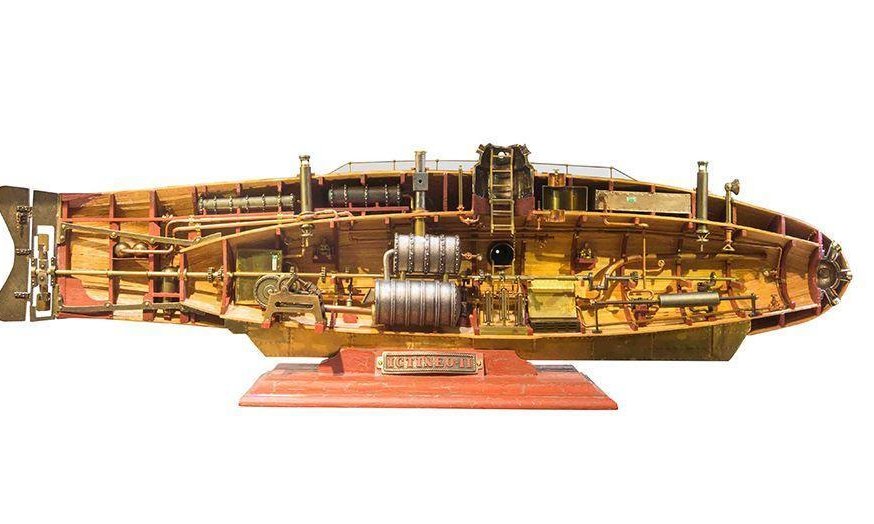
https://www.rmk-museum.org.tr/ankara/en/collection/maritime/ictineo-ii-submarine-model
Ictineo II was the first combustion engine-driven submarine, propelled by an early form of air-independent propulsion. Ictineo II was launched on 2 October 1864 by Spanish inventor Narcis Monturiol Estarriol as an improved version of Ictineo I. It was not until the 1940s, that smilar principles were used for propulsion.
John Philip Holland
Father of today’s Submarines - 1898
“John Philip Holland (born February 24?, 1841, Liscannor, County Clare, Ireland—died August 12, 1914, Newark, New Jersey, U.S.) was an Irish-born inventor who was the father of the modern submarine. He designed and built the first underwater vessel accepted by the U.S. Navy.”
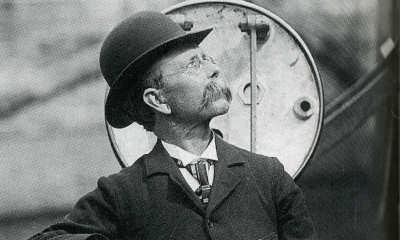
John Philip Holland Father of today’s Submarines - 1898 “John Philip Holland (born February 24?, 1841, Liscannor, County Clare, Ireland—died August 12, 1914, Newark, New Jersey, U.S.) was an Irish-born inventor who was the father of the modern submarine. He designed and built the first underwater vessel accepted by the U.S. Navy.”
Following his work in the early 1890s, the design that John Holland presented to the US Navy in 1898 has formed the basis of the designs for all submarines built since.
These features include:
- “Efficient hydrodynamic hull shape [teardrop-shape with bulbous bow and tapered stern] with good seakeeping ability on the open ocean.
- Separate main and auxiliary ballast systems enable rapid diving and surfacing with minimial changes to the longitudinal center of gravity while underway.
- Accomplished by operating with full or nearly full ballast tanks when submerged.
- Allowed precise control of trim angle while submerged.
- Able to dive to and accurately maintain a significant depth [up of 75 feet (23 m)].
- Diving planes provide the means to precisely control depth [stern planes only, located behind the propeller].
- Dual propulsion systems driving a single propeller at the stern.
- Internal combustion engine provides reliable power on the surface, enabling long transits while charging the batteries [up to 200 nautical miles (370 km) at 6 knots]
- Lead-acid storage batteries provide power to run submerged for a considerable distance [about 30 nautical miles (56 km) at 5.5 knots].
- Conning tower for directing ship and weapons activities on the surface or semi-submerged.
- No periscope. View ports around the top of the conning tower provided the commander with intermittent views while “porpoising” semi-submerged near the surface.
- Offensive weapons systems.
- One reloadable torpedo tube at the bow, with three self-propelled torpedoes carried internally.
- One pneumatic dynamite gun at the bow that, on the surface, fired large projectiles, sometimes called “aerial torpedoes.” [This was subsequently removed].
John P. Holland first demonstrated the Holland VI to the U.S. Navy on 17 March 1898.”18
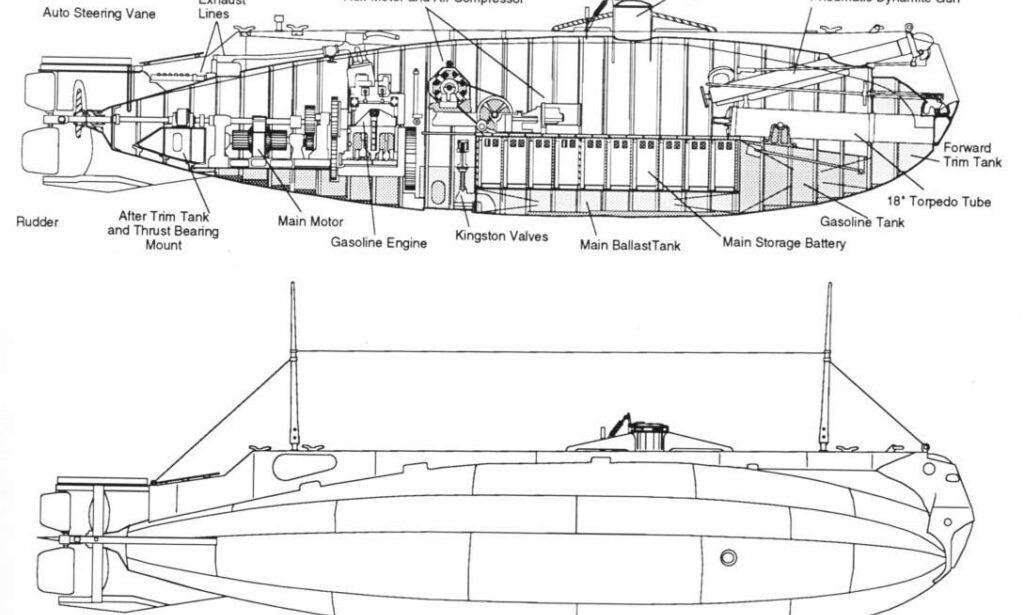
https://lynceans.org/all-posts/a-brief-look-back-at-the-worlds-first-modern-submarine-2/
USS Holland (SS-1) internal and external arrangements. The interior space was one contiguous compartment.
Internal Combustion Engine (ICE) – Key to Submarine Design
The principles that make up a successful submarine design were well understood by the 1890s. It was the development of the internal combustion engine that made the submarine a practical proposition.
Petrol Engines
The first ICE powered submarines used petrol engines. However, the petrol fumes in the submarine badly effected its crew, and on occasion almost prevented the submarine from performing its task.
Diesel Engines
The greater power density of a diesel engine made them more attractive for submarines, and their added benefit that while diesel fumes are no more attractive than petrol fumes their effects on human performance do not seem quite as disabling. From 1910 diesel engines were fitted in submarines.
The diesel engine charging a lead acid battery to power the submarine became the preferred propulsion line up until nuclear powered submarines were developed.
The Beginning of Submarines in the US Navy
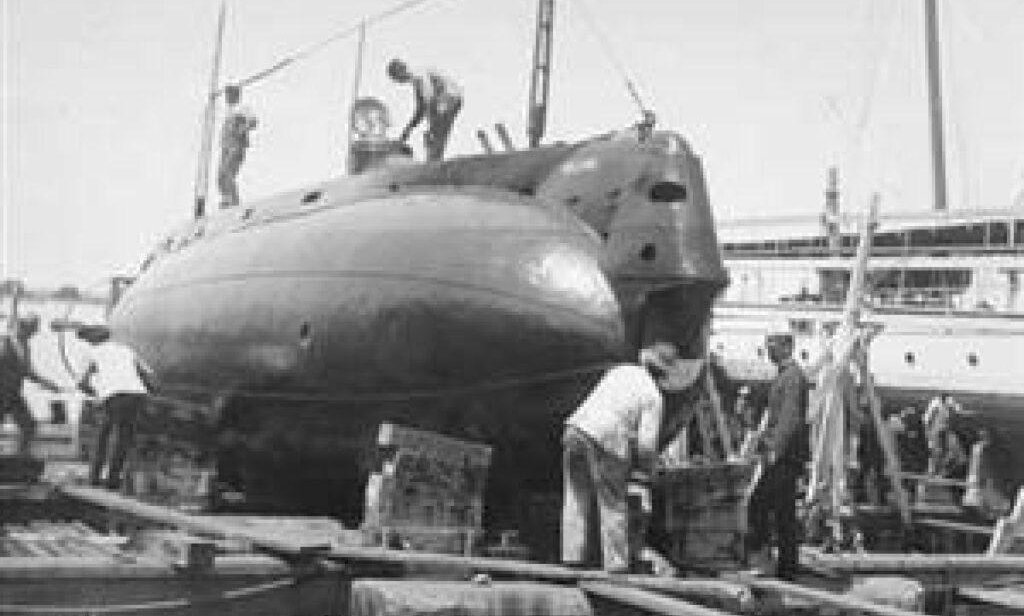
Image provided by United States Naval Institute (photo archive)
Starboard bow view of USS Holland (SS-1) in drydock.
“Following meetings with the Admiralty, an agreement was made on 27th October 1900 between the Electric Boat Company and Vickers Sons & Maxim Ltd of Barrow-in-Furness, giving Vickers 25-year licence to manufacture the Holland-class of submarines, using Electric Boats patents.
In addition to the United Kingdom, the licence also covered the whole of Europe and allowed Vickers to grant sub-licences to other firms and countries.
The Royal Navy had not originally been enthusiastic about the idea of submarines but by the end of the 19th Century they were becoming increasingly concerned by the emphasis being placed on them in France. This led to major concerns regarding the defence of the realm.
In America, The Electric Boat Company had built their submarine ‘Holland’ for the US Navy and following its customer acceptance in 1900, company owner (Isaac Rice) visited the UK as part of a tour seeking orders from the European nations.
The first boats to be built at Vickers’ Barrow Shipyard were five vessels for the Royal Navy after the Admiralty had placed an order in December 1900. Subsequent to placing the order, they sent a Captain Reginald Bacon to Cumbria to oversee the construction.
Apparently, the negotiations had been carried out so quickly that the Admiralty had to ask the Treasury for the funds to pay for the already ordered submarines – Such was the excitement surrounding the new innovation that permission was given just three days later!
The first appointed Commanding Officer (Lieutenant F Arnold-Foster) was also dispatched to Barrow and was very keen to see his new command. He later recalled that no-one in Barrow appeared to be aware of a submarine being built in the shipyard, until it was eventually found in a building with a sign over the door that read 'Yacht Shed’. Such was the secrecy that any of the parts being delivered marked simply as ‘Pontoon Number One’.
Holland submarines were 63’ 4” in length, with a breadth of 11’ 9”, carried a crew of eight and were armed with a single torpedo tube. A speed of about 8-knots could be achieved on the surface, produced by the 160hp gasoline engine - using the 70 HP electric motor whilst submerged the vessel could still make 6-7 knots. The surface range was recorded as around 600 miles, weather dependent and they could run submerged for about four hours.
The first vessel, HMS Holland 1, was launched on 2nd October 1901 and it saw a chequered service career.”
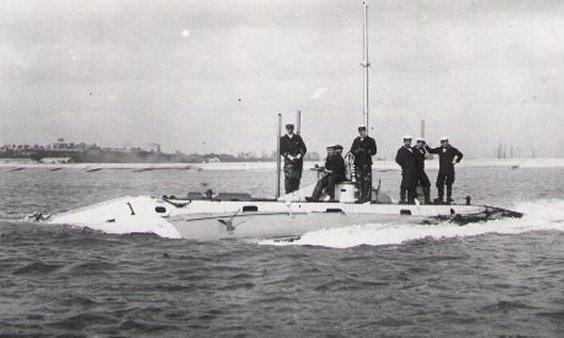
https://www.baesystems.com/en-uk/heritage/holland-class-submarines
HMS Holland 1 underway
Further Reading
1 https://publicdomainreview.org/collection/alexander-bathysphere/
2 https://www.britannica.com/science/Archimedes-principle
3 https://mostre.museogalileo.it/codiceleicester/en/water/50-leonardo-s-submarine
4 https://mostre.museogalileo.it/codiceleicester/en/water/50-leonardo-s-submarine
5 https://www.britannica.com/biography/Cornelis-Jacobszoon-Drebbel
6 https://londonist.com/london/history/king-james-submarine-thames
7 https://www.scienceandthesea.org/program/first-submarine
8 https://www.lindahall.org/about/news/scientist-of-the-day/cornelis-drebbel/
9 https://www.si.edu/object/model-turtle:nmah_1063162 15 https://www.history.navy.mil/research/underwater-archaeology/sites-and-projects/ship-wrecksites/hl-hunley.html
11 https://warfarehistorynetwork.com/article/weapons-confederate-submarine-h-l-hunley
13 https://www.amusingplanet.com/2021/03/hunley-submarine-that-wouldnt-come-up.html
14 https://www.rmk-museum.org.tr/ankara/en/collection/maritime/ictineo-ii-submarine-model
15 https://www.britannica.com/biography/John-Philip-Holland
16 https://lynceans.org/all-posts/a-brief-look-back-at-the-worlds-first-modern-submarine-2/
17 https://www.baesystems.com/en-uk/heritage/holland-class-submarines